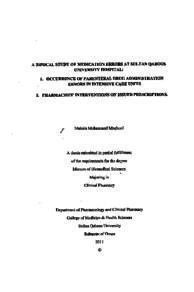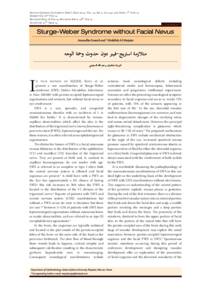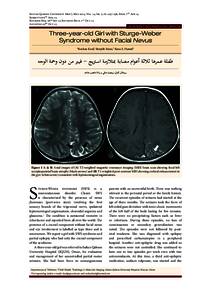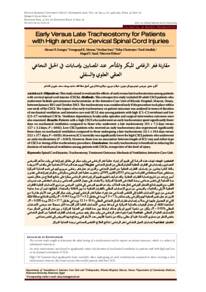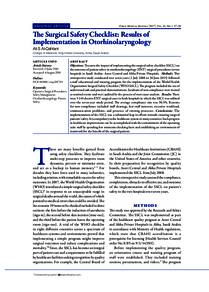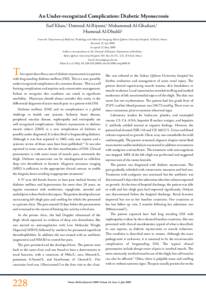Document
A Bifocal study of medication errors at Sultan Qaboos university hospital: 1. occurrence of parenteral drug administration errors in intensive care units. 2. pharmacists' interventions at out-patient department on issued prescriptions.
Publisher
Sultan Qaboos University
Gregorian
2011
Language
English
Subject
English abstract
A Bifocal Study of Medication Errors at Sultan Qaboos University Hospital.
Background: Medication errors are a serious concern of many healthcare organizations around the world. Ensuring patient safety is prime motive of many healthcare professionals. The human errors can be prevented if the system is made more resilient to errors, rather than working on individuals. A study conducted in Vienna revealed that almost one in five (19%) patients experienced one medication error and 14% experienced more than one error in intensive care units (ICUS). Medication errors in intensive care units affect one of the most vulnerable populations in the hospital. Since previous studies suggest that these errors can be reduced by improving organizational factors such as error reporting systems and routine checks, the purpose of this study was to help understand the underlying factors behind these errors and help us in prevention of these responsible factors. Pharmacists are playing a major role in catching these errors and reporting them. Interventions conducted by pharmacists are central in any organization, in order to ensure patient safety.
1. Occurrence of Parenteral Drug Administration Errors in Intensive Care Units.
Objective: To determine the frequency, characteristics and contributing factors of parenteral drug administration errors in Intensive care units and to suggest preventive measures.
Methods:
ii.
Design: A prospective cohort study over a period of three months by using self reporting method by hospital staff. Setting: All intensive care units in Sultan Qaboos University Hospital (SQUH). Participants: All patients staying in intensive care units in three months period.
iii.
Results: The occupancy rate of 120 patients in 558 bed days was 4.65 patients per bed day. In about 48.8% of patient bed-days, Continuous IV was used. Bolus IV was used in 44.6% and Subcutaneous in 6.6%. Antimicrobials were found to be used the most parenterally (21.4%), followed by Insulin (18.6%) and Sedatives/Analgesics (14.3%). No error report was received over a period of three months.
Conclusion: The issue of under-reporting needs to be addressed. The blame-free environment needs to be developed absence of which is hampering the healthcare staff to report errors independently.
2. Pharmacists' Interventions at Out-Patient Department on Issued Prescriptions.
Objective: To characterize the interventions carried out by the pharmacists at pharmacy department of SQUH.
Methods:
ii,
Design: A prospective study conducted over a period of 6 months by using pharmacist intervention form. Setting: Pharmacy department receiving prescriptions from Sultan Qaboos University Hospital (SQUH), Sultanate of Oman. Subjects: All completed interventions forms.
Results: Total 530 interventions were carried out for six months on 104055 prescriptions (rate = 0.5%). The administrative interventions were 0.4% whereas the clinical interventions were 99.6% (choice of drug = 22.5% and regimen = 77.1%). Dose related errors were the highest (40.9%) followed by frequency (15.8%. In 10% of the cases, a wrong drug was prescribed. Efficacy improved in 53% of the cases, avoided toxicity in 27.4% and avoided unnecessary exposure in 16.8%, Interventions prevented death or major organ damage in 2.1% cases, major in 31.9% and moderate in 40.8% cases. The average time consumed per prescription was 15.8 minutes.
Conclusion: Pharmacists play a vital role on catching the errors and reporting them thus ensuring patient safety.
Member of
Resource URL
Arabic abstract
هي دراسة ثنائية التركيز على الأخطاء الطبية في مستشفى جامعة السلطان قابوس.
الخلفية: تعتبر الأخطاء الطبية هي مجال اهتمام الكثير من المؤسسات الطبية حول العالم. حيث أن ضمان سلامة المريض هي الدافع الأساسي للكثير من العاملين في مجال الرعاية الصحية ويمكن تجنب الأخطاء البشرية إذا تم عمل نظام أكثر مرونة للأخطاء، بخلاف العمل بشكل فردي. تم عمل دراسة في فيينا وكشفت أن مريض من بين كل خمسة مرضى (19%) يتعرض لخطأ طبي ونسبة 14% يتعرضون لأكثر من خطأ طبي واحد في وحدات الرعاية المركزة. تؤثر الأخطاء التي تحدث في وحدات الرعاية المركزة بشكل كبير على سمعة وشعبية المستشفى. ونظرا العمل الكثير من الدراسات السابقة التي اقترحت أنه يمكن تقليل نسبة الخطأ من خلال تطوير العوامل المؤسسية مثل أنظمة الإبلاغ عن الأخطاء والفحوصات الدورية، وكان الغرض من هذه الدراسة هو المساعدة على فهم العوامل الخفية التي تتسبب في حدوث الأخطاء ومساعدتنا على تجنب هذه العوامل. يقوم الصيادلة بدور كبير في اكتشاف هذه الأخطاء والإبلاغ عنها. وتعتبر المداخلات التي يتم عملها بواسطة الصيادلة جزء مركزي من أي مؤسسة وذلك من أجل ضمان سلامة المرضى
1- حدوث أخطاء إدارة العقاقير التي يتم حقنها في وحدات الرعاية المركزية الهدف: لتحديد التكرار والخصائص والعوامل التي تشارك في أخطاء إدارة العقاقير في وحدات الرعاية المركزة واقتراح معايير لتجنب ذلك. الأساليب - التصميم: دراسة مركزة خلال مدة قدرها ثلاث أشهر باستخدام أسلوب الإبلاغ الذاتي
بواسطة فريق عمل المستشفى . الإعداد: كافة وحدات الرعاية المركزة في مستشفى السلطان قابوس. - المشاركون: كل المرضى الموجودين في وحدة الرعاية المركزة خلال فترة الثلاث أشهر هذه
النتيجة: كان معدل الشغل 120 مريض في 558 يوم سريري هو 4 . 65 مريض لكل يوم سريري. في حوالي نسبة 48 . 8 من الأيام السريرية للمرضى، تم استخدام الحقن المستمر. وتم استخدام الحقن المثبت بنسبة 44 . 6 % والحقن تحت الجلد بنسبة 6 . 6 % وتم استخدام مضادات الميكروبات بنسبة 21 . 4 % يتبعه الأنسولين بنسبة 18 . 6 % والمهدئات المسكنات بنسبة 14 . 3 %. ولم يتم تلقي
أي تقرير عن حدوث خطأ خلال فترة الثلاث أشهر.
الخاتمة: يجب أن يتم حل مشكلة الإبلاغ عن المشكلات. البيئة الخالية من الأخطاء يجب أن تكون خالية من العوائق التي تمنع فريق عمل الرعاية الصحية من الإبلاغ عن الأخطاء بشكل فردي.
2- مداخلات الصيادلة في قسم مرضى العيادة الخارجية على الوصفات الطبية الصادرة.
الهدف: لوصف المداخلات التي تتم بواسطة الصيادلة في قسم الصيدلة بمستشفى السلطان قابوس.
الأساليب
- التصميم: دراسة مركزة يتم عملها خلال فترة 6 أشهر باستخدام نموذج مداخلات الصيادلة.
. الإعداد: قسم صيدلة يتلقى الوصفات الطبية من مستشفى السلطان قابوس، سلطنة عمان.
- الموضوع: كافة نماذج المداخلات المكتملة النتيجة: كان إجمالي المداخلات هو و35 مداخلة تم عملها خلال 6 أشهر على 104055 وصفة
طبيبة (المعدل: 0 . 5 %). وكانت نسبة المداخلات الإدارية هي 0 . 4 % بينما المداخلات الطبية كانت بنسبة 99 . 6 % (اختبار العقار بنسبة 22 . 5 % والتدبير 77 . 1 %). وكانت الأخطاء المتعلقة بالجرعة هي الأعلى من حيث النسبة حيث بلغت 40 . 9 % متبوعة بتكرار بنسبة 15
. 8 %. وتم كتابة وصفات طبية بالخطأ في 10% من الحالات. تحسنت الفعالية بنسبة 53% من الحالات وتم تجنب السمية بنسبة 27 . 4 % وتم تجنب التعرضات غير الضرورية بنسبة 16 . 8 %، أدت المداخلات إلى تجنب حدوث الموت أو الضرر العضوي الكبير في نسبة 2 . 1 % من الحالات.
وكان الحالات المتوسطة بنسبة 31 . 9 %. وكان معدل الوقت المنقضي في كل وصفة هو حوالي 15 . 8 دقيقة الخاتمة: يقوم الصيادلة بدور حيوي في اكتشاف الأخطاء والإبلاغ عنها مما يؤدي إلى ضمان سلامة المرضى.
الخلفية: تعتبر الأخطاء الطبية هي مجال اهتمام الكثير من المؤسسات الطبية حول العالم. حيث أن ضمان سلامة المريض هي الدافع الأساسي للكثير من العاملين في مجال الرعاية الصحية ويمكن تجنب الأخطاء البشرية إذا تم عمل نظام أكثر مرونة للأخطاء، بخلاف العمل بشكل فردي. تم عمل دراسة في فيينا وكشفت أن مريض من بين كل خمسة مرضى (19%) يتعرض لخطأ طبي ونسبة 14% يتعرضون لأكثر من خطأ طبي واحد في وحدات الرعاية المركزة. تؤثر الأخطاء التي تحدث في وحدات الرعاية المركزة بشكل كبير على سمعة وشعبية المستشفى. ونظرا العمل الكثير من الدراسات السابقة التي اقترحت أنه يمكن تقليل نسبة الخطأ من خلال تطوير العوامل المؤسسية مثل أنظمة الإبلاغ عن الأخطاء والفحوصات الدورية، وكان الغرض من هذه الدراسة هو المساعدة على فهم العوامل الخفية التي تتسبب في حدوث الأخطاء ومساعدتنا على تجنب هذه العوامل. يقوم الصيادلة بدور كبير في اكتشاف هذه الأخطاء والإبلاغ عنها. وتعتبر المداخلات التي يتم عملها بواسطة الصيادلة جزء مركزي من أي مؤسسة وذلك من أجل ضمان سلامة المرضى
1- حدوث أخطاء إدارة العقاقير التي يتم حقنها في وحدات الرعاية المركزية الهدف: لتحديد التكرار والخصائص والعوامل التي تشارك في أخطاء إدارة العقاقير في وحدات الرعاية المركزة واقتراح معايير لتجنب ذلك. الأساليب - التصميم: دراسة مركزة خلال مدة قدرها ثلاث أشهر باستخدام أسلوب الإبلاغ الذاتي
بواسطة فريق عمل المستشفى . الإعداد: كافة وحدات الرعاية المركزة في مستشفى السلطان قابوس. - المشاركون: كل المرضى الموجودين في وحدة الرعاية المركزة خلال فترة الثلاث أشهر هذه
النتيجة: كان معدل الشغل 120 مريض في 558 يوم سريري هو 4 . 65 مريض لكل يوم سريري. في حوالي نسبة 48 . 8 من الأيام السريرية للمرضى، تم استخدام الحقن المستمر. وتم استخدام الحقن المثبت بنسبة 44 . 6 % والحقن تحت الجلد بنسبة 6 . 6 % وتم استخدام مضادات الميكروبات بنسبة 21 . 4 % يتبعه الأنسولين بنسبة 18 . 6 % والمهدئات المسكنات بنسبة 14 . 3 %. ولم يتم تلقي
أي تقرير عن حدوث خطأ خلال فترة الثلاث أشهر.
الخاتمة: يجب أن يتم حل مشكلة الإبلاغ عن المشكلات. البيئة الخالية من الأخطاء يجب أن تكون خالية من العوائق التي تمنع فريق عمل الرعاية الصحية من الإبلاغ عن الأخطاء بشكل فردي.
2- مداخلات الصيادلة في قسم مرضى العيادة الخارجية على الوصفات الطبية الصادرة.
الهدف: لوصف المداخلات التي تتم بواسطة الصيادلة في قسم الصيدلة بمستشفى السلطان قابوس.
الأساليب
- التصميم: دراسة مركزة يتم عملها خلال فترة 6 أشهر باستخدام نموذج مداخلات الصيادلة.
. الإعداد: قسم صيدلة يتلقى الوصفات الطبية من مستشفى السلطان قابوس، سلطنة عمان.
- الموضوع: كافة نماذج المداخلات المكتملة النتيجة: كان إجمالي المداخلات هو و35 مداخلة تم عملها خلال 6 أشهر على 104055 وصفة
طبيبة (المعدل: 0 . 5 %). وكانت نسبة المداخلات الإدارية هي 0 . 4 % بينما المداخلات الطبية كانت بنسبة 99 . 6 % (اختبار العقار بنسبة 22 . 5 % والتدبير 77 . 1 %). وكانت الأخطاء المتعلقة بالجرعة هي الأعلى من حيث النسبة حيث بلغت 40 . 9 % متبوعة بتكرار بنسبة 15
. 8 %. وتم كتابة وصفات طبية بالخطأ في 10% من الحالات. تحسنت الفعالية بنسبة 53% من الحالات وتم تجنب السمية بنسبة 27 . 4 % وتم تجنب التعرضات غير الضرورية بنسبة 16 . 8 %، أدت المداخلات إلى تجنب حدوث الموت أو الضرر العضوي الكبير في نسبة 2 . 1 % من الحالات.
وكان الحالات المتوسطة بنسبة 31 . 9 %. وكان معدل الوقت المنقضي في كل وصفة هو حوالي 15 . 8 دقيقة الخاتمة: يقوم الصيادلة بدور حيوي في اكتشاف الأخطاء والإبلاغ عنها مما يؤدي إلى ضمان سلامة المرضى.
Category
Theses and Dissertations

